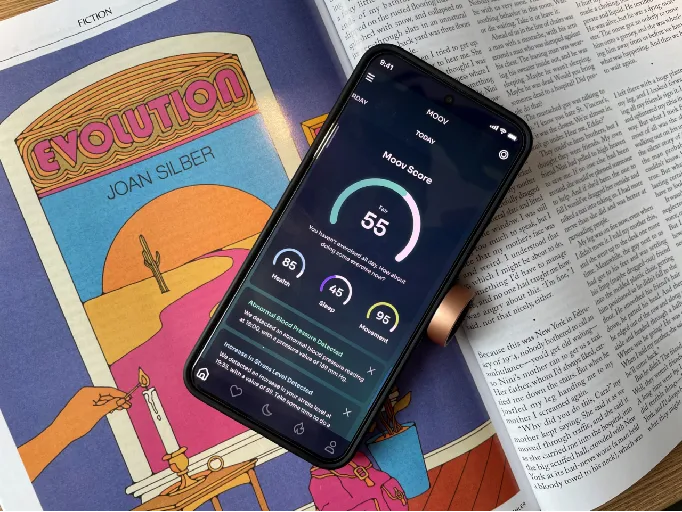If you prefer not to wear anything on your wrist, slip the MOOV Ring onto your fingers and the $239 sensor-packed wearable tracks dynamic blood pressure, calories burned, stress level and even menstrual management insights. I was curious to see how this so-called dynamic blood pressure tracker would stack up against options like the $299+monthly fee Oura Ring and $279 RingConn. Here are my thoughts after testing it out.
The continuous Blood Pressure features
Dynamic BP strikes me as some device often seen in hospitals. For someone who used an OMRON BP monitor at home, I am all about to understand how this works compared with the chunky, cube-shaped monitors. If this thing works as promised, it’ll definitely save the hassle of pulling out the monitor every time.
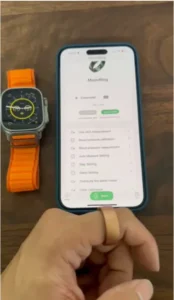
My testing took about 30s while I just kept my finger steady and watched the dynamic waveform on my phone, which made the process intuitive. First, the heart rate appeared, updating almost every second. Then, the SpO2 reading came in, and finally, the diastolic/systolic numbers showed up. This kind of data transparency and dynamic feedback isn’t something you typically find in other wearables.
One thing to note, though: you have to keep your hand steady, or the waveform gets distorted. It would make more sense if they could perfect the stability.
The Accuracy
Function works as advertised but accuracy is obviously more important for daily use.
So I tested it alongside my cuff BP monitor to see how it stacks up.
I put on the cuff and measured my blood pressure and heart rate. Here are the results
Diastolic/Systolic: 125/88 mmHg
Heart Rate: 77 bpm
I did the same with the MOOV Ring, and the results were:
Diastolic/Systolic: 125/85 mmHg
Heart Rate: 79 bpm
The results were quite close, indicating that the ring provides a reasonably accurate measurement. At least I get to know if my BP is not quite normal.
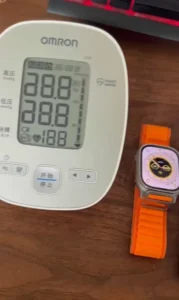
MOOV Ring Design
At $239, the MOOV Ring offers a more affordable option compared to Oura Ring, which starts at $299 and has a recurring $5.99/month membership fee. You can click here to check their website and the product.
You can choose from five colors – stealth black, silver, rose gold, teal and white – and sizes ranging from US 6 to 13. The company recommends wearing it on the index finger, but other fingers work well too, as I found during testing. A free sizing kit is provided to get my best fit.
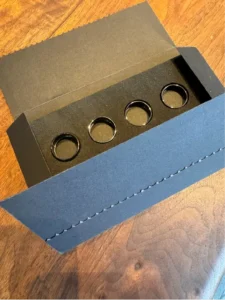
The MOOV Ring is available in titanium, aluminum alloy, and medical-grade ceramic, depending on the color you choose, but they all come with a PVD coating and non-metallic, hypoallergenic inner molding. After weeks of wearing it, I’ve noticed that the ring still looks new, with no visible scratches.
I chose the rose gold version, made from aluminum. Its coating is refined, and the matte texture feels quite delicate, similar to the finish on Apple Mac products. It feels more like wearing a piece of art than a typical metal ring.
The ring operates with a 5 ATM rating, meaning it can withstand dust and submersion in water up to 165 feet. It also operates in temperatures ranging from -4 to 122 degrees Fahrenheit, making it functional for various conditions.
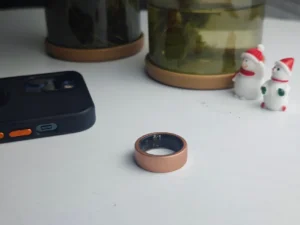
Wireless Charging
Fitting the ring onto the dock is straightforward. Simply slot the ring around the raised protrusion and align the sensor bumps with the corresponding slots. Once everything is in place, the indicator light turns on, signaling that the ring is correctly positioned and charging. I found this process to be convenient during my testing.
One thing I like about wireless charging is its potential to enhance the overall durability. By eliminating the need for physical charging contact, you reduce the wear and tear that happens with regular plugging and unplugging.
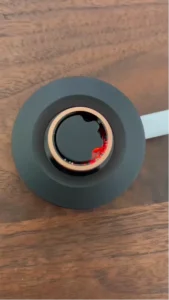
The ring measures about 0.25 inches wide and 0.1 inches thick, which is pretty standard for smart rings on the market. One thing I noticed is the curves and contoured touch on its surface, which are hard to spot but make a difference in how it feels. The edges fit naturally against my finger, which seems to add to the comfort.
I wore it for a week while sleeping, and it felt weightless compared to watches or wristbands. But it did bother me when lifting heavy weights, clacking against whatever I was holding, which was distracting. I decided not to wear it during bench press or other types of weightlifting. It is something to keep in mind if you are into weightlifting.
The company claims the battery lasts up to 7 days, though you might find yourself needing to charge it a bit sooner if you take more than five blood pressure measurements a day. It really varies based on how you’re using the ring. I appreciate that it lasts longer than most smartwatches, like the Apple Watch, which typically needs recharging every 2-3 days.
Once it’s fully charged and on your finger, the ring uses a variety of sensors to gather insights into your health. During the day, it keeps track of your activity levels, calories burned, heart rate, heart rate variability (HRV), respiration, skin temperature, and stress index. At night, it shifts to monitoring your blood oxygen saturation (SpO2), heart rate, HRV, respiratory rate, and skin temperature. It also tracks how long you sleep, your movement during the night, sleep efficiency, stability, and stages, ultimately giving you an overall sleep score.
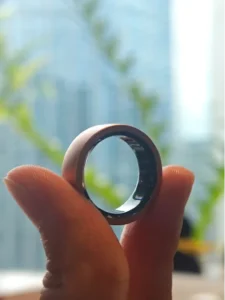
You can check your blood pressure either reactively or proactively, whether you’re awake or asleep, depending on your needs.
It was mentioned on The company’s website that they’ve been developing blood pressure technology for the past 10 years, resulting in a product that tracks dynamic blood pressure and has earned FDA certification. They’re currently in the process of working closely with the FDA to get this ring product certified as well.
The MOOV Ring App
I guess being able to gather so many insights from your fingertips requires some compromises. Obviously, there’s no room for even a tiny screen on the ring itself, so you need to pair it with your phone to view all the data it collects from your body. The setup guide is provided in the user manual, and, like many other wearables, it connects to your phone via Bluetooth. When you open the MOOV Ring app, you’ll be prompted to pair your ring and create an account. The ring comes with some charge, so you can connect it as soon as you get it out of the box.
To start getting useful information, you need to wear the ring for at least a day and a night. It collects data continuously and syncs automatically over Bluetooth when you open the app. The MOOV Ring can store information for five to seven days between syncs, which is handy if you forget to open the app for a while. However, it doesn’t sync in the background to save battery life, so if you open the app for the first time in a few days, expect the syncing process to take a couple of minutes.
By default, the app opens to the ‘MOOV Score’ tab, which features sections at the top for Summary, Health, Sleep, and Movement. Think of it as a scoreboard that provides an overall snapshot of your well-being, all summarized into a single score with three subsections. Each subsection includes data collected over time, giving you an intuitive overview of areas that might need more attention.
However, I presume that not everyone wants to see everything broken down into numbers all the time. It might be useful if there was an option to toggle certain metrics on or off, allowing you to customize what you see based on your personal preferences.
I’m fine with the numbers. I usually check in only a few times a day, and I don’t feel anxiety from the details.
The health score specifically includes metrics that are primarily related to cardiovascular functions, such as your latest blood pressure, heart rate, and HRV (heart rate variability). It even tracks your temperature down to 0.1-degree increments. This level of detail can provide a comprehensive picture of your health, but it might feel a bit overwhelming if you’re not into detailed numbers.
I found the sleep tab to be the most useful for my personal well-being, as I often struggle to get high-quality sleep. This tab breaks down my sleep into different stages, including REM, deep, light, and awake time, showing the proportion of each stage. It also tells you how many hours of sleep I’ve gotten. I usually look for guidance on how to improve my sleep, and this feature serves as a reminder to stick to my rest and recovery routine.
The app does a good job of making the data easy to understand. It provides notes that explain the analytics of my sleep, which I find helpful. Instead of just showing the data, it offers insights that help me understand what’s going on with my sleep patterns.
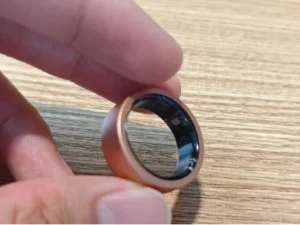
The ‘Movement’ tab is easy to navigate. It breaks down everything into sections for exercise time, steps counted, stand hours, and calories burned over each period. It uses a ring setup for each section, acting like independent progress circles. When you hit your daily goal, the ring closes, which can feel quite rewarding. It also serves as a reminder of what still needs to be done.
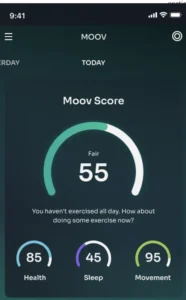
You can scroll down and click on each section to see more details. While it doesn’t track specific types of exercise, it provides a comprehensive overview of your activity levels.
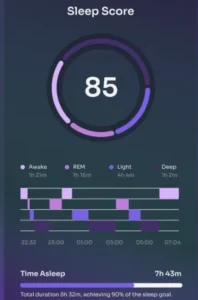
The overall experience is straightforward and offers flexibility. You’re not overwhelmed with tons of data, but do have the option to dig deeper into the details if you want to. This is a plus compared to other wearable apps that can sometimes overload you with information. It gives you just the right amount of control over what you see.
